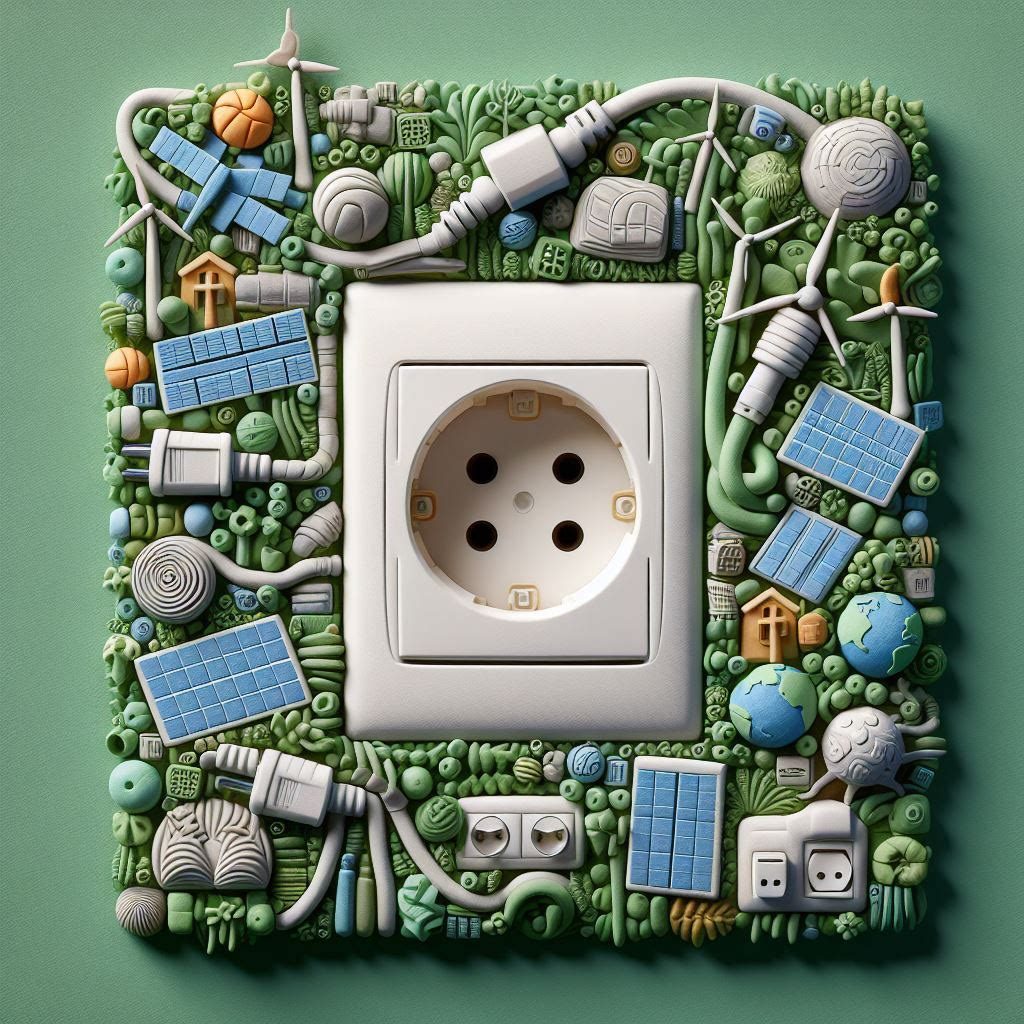
A Sustainable But CHallenging Path Forward
In our quest for a cleaner and more sustainable future, renewable energy plays a pivotal role. As we gradually shift away from fossil fuels, understanding the various forms of renewable energy becomes essential. Let’s delve into the key types:
- Solar Energy
Harnessing the Sun’s Power
Solar panels convert sunlight into electricity, offering an abundant and inexhaustible energy source. The pros of solar energy include zero emissions and low operating costs. However, the initial setup expenses can be substantial.
- Wind Energy
Turning Breezes into Electricity
Wind turbines dot the landscape, transforming wind energy into usable power. Wind farms, especially prevalent in windy regions, have several advantages. These include no fuel costs and minimal environmental impact. However, wind energy supply is intermittent, and the visual and noise impact can be a drawback.
- Hydropower
Flowing Water, Reliable Electricity
Hydropower taps into the energy of flowing water—whether from rivers, dams, or tides—to generate electricity. With a long history, hydropower offers clean energy and a dependable supply. However, building dams can disrupt ecosystems, and the upfront costs are significant.
- Geothermal Energy
Earth’s Inner Heat Unleashed
Geothermal power plants utilize Earth’s internal heat to produce electricity. The benefits include a constant energy supply and minimal emissions. However, geothermal energy is site-specific, requiring drilling and exploration costs.
- Biomass Energy
Powering Homes and Industries
Derived from organic materials like wood and agricultural waste, biomass energy contributes to renewable energy solutions. It reduces waste and offers a sustainable alternative. However, biomass combustion does produce emissions, and land use must be carefully managed.
- Tidal Energy
Harvesting Ocean Tides
Tidal power captures energy from ocean tides, providing a predictable energy source. Its reliability and lack of greenhouse gas emissions are significant advantages. However, limited suitable locations and high infrastructure costs pose challenges.
- Hydrogen
The Versatile Fuel
While not directly a renewable energy source, hydrogen can be produced using renewable electricity. Its versatility, stability and adptability makes it valuable for various applications. Hydrogen has zero emissions, but production and storage complexities remain hurdles.
Advantages of Renewable Energy
As we steer toward a cleaner and more sustainable future, renewable energy emerges as our beacon of hope. Let’s explore its key advantages:
Inexhaustible: Unlike fossil fuels, renewable resources won’t run dry. They offer a perpetual wellspring of energy.
Lower Maintenance: Renewable systems demand minimal upkeep. This means less upkeep to frequent repairs and high maintenance costs.
Cost Savings: Over the long term, renewable energy translates to significant savings. Reduced operating costs mean more money in your pocket.
Environmental Benefits: Cleaner air, purer water, and a smaller carbon footprint—renewable energy contributes to a healthier planet.
Energy Independence: By relying less on foreign energy sources, we strengthen our autonomy and resilience.
Job Creation: The renewable energy sector is a job generator. From solar panel installation to wind turbine maintenance, employment opportunities abound.
Challenges and Long-Term Developments
While the advantages are clear, we must address some challenges:
Storage Solutions: Efficient energy storage systems are essential to overcome the intermittency of renewable sources.
Grid Integration: Integrating renewable energy into existing grids requires investment and smart infrastructure upgrades.
Research and Innovation: Continued exploration can enhance efficiency and drive down costs.
Policy Support: Governments play a crucial role by providing incentives and regulations that foster renewable adoption.
Cost Factors
Consider these financial aspects:
Initial Investment: Setting up renewable infrastructure may be costly initially, but the long-term benefits outweigh the expense.
Operating Costs: Generally lower than fossil fuels, but regular maintenance remains vital.
Lifecycle Costs: From installation to decommissioning, the entire lifecycle must be factored in.
Environmental Benefits
Reduced Emissions: Renewable sources produce minimal to no greenhouse gases, effectively combating climate change.
Clean Air and Water: Unlike fossil fuels, renewables don’t release harmful pollutants into the environment.
Preservation of Ecosystems: Hydropower and wind energy have minimal impact on ecosystems compared to coal mining or oil drilling.
Inexhaustible and Abundant:
Solar and Wind: Sunlight and wind are virtually limitless resources, available everywhere.
Hydropower: Rivers and tides flow continuously, providing a constant energy supply.
Geothermal: Earth’s heat remains unwavering, offering a reliable source of power.
Energy Independence:
By relying on renewables, we reduce our dependence on foreign oil and gas.
Localized production enhances energy security and resilience.
Embrace renewable energy—it’s our sustainable path forward!
Pros and Cons of Renewable Energy
A Sustainable Path Forward
Renewable energy not only benefits the environment but also contributes significantly to our economic well-being. Let’s explore both sides of the renewable story
Pros of Renewable Energy
Job Creation:
The renewable energy sector is a job generator.
From manufacturing solar panels to maintaining wind turbines, employment opportunities abound.
Low Operating Costs:
Once installed, renewables have minimal ongoing expenses.
Solar panels and wind turbines require little maintenance, reducing operational costs.
Cons of Renewable Energy
Intermittency:
Solar and Wind: Energy production has this issue as it does fluctuate based on weather conditions.
Tidal and Hydropower: These sources are dependent on natural cycles, which can impact reliability.
High Initial Costs:
Setting up solar panels, wind farms, or hydropower plants can be expensive initially.
However, costs are decreasing as technology improves.
Land Use Concerns:
Large-scale solar and wind projects require significant nearly flat land and way to get around these projects.
Balancing energy needs with environmental preservation is crucial as if done wrong can damage environemnts and or change how projects work long term.
Visual Impact and Noise:
Wind turbines and solar arrays can alter landscapes.
Some people find them visually intrusive, affecting local aesthetics.
Challenges and Long-Term Developments in Renewable Energy
A Sustainable Path Forward
While renewable energy offers numerous benefits, we must address certain challenges to ensure its widespread adoption. Let’s explore these hurdles and the ongoing developments:
Ecosystem Disruption:
Hydropower Dams: Building dams for hydropower alters river ecosystems and disrupts fish migration patterns.
Wind Farms: Wind turbines may impact bird populations and local wildlife.
Storage Challenges:
Storing excess energy for cloudy days or calm nights remains a critical challenge.
Advances in battery technology are gradually addressing this issue, making energy storage more efficient.
Long-Term Developments
Storage Solutions:
Efficient energy storage systems are essential for overcoming the intermittency of renewable sources.
Innovations like batteries and pumped hydro storage are actively being developed.
Grid Integration:
Integrating renewables into existing grids requires investment and smart infrastructure.
Smart grids can effectively balance energy supply and demand, ensuring stability.
Research and Innovation:
Continued research can enhance the efficiency of renewable technologies and drive down costs.
New materials and designs are constantly emerging, pushing the boundaries of what’s
possible.
Policy Support:
Governments play a crucial role in promoting renewable adoption.
Incentives such as tax credits, feed-in tariffs, and net metering encourage investment and growth.
The Transition To Renewable Energy With Opportunities & Challenges
A Sustainable Shift
The global shift toward renewable energy sources isn’t merely a passing trend—it’s an imperative for a sustainable future. Countries and communities worldwide are actively navigating this transition. Let’s delve into some key aspects:
Australia’s Journey
Australia, like many other nations, faces a multifaceted transition toward cleaner energy. Here are the critical challenges they encounter:
Aging Infrastructure:
Upgrading outdated power grids and transmission lines is paramount.
Aging infrastructure not only poses reliability risks but also hinders efficient energy distribution.
Distributed Energy Resources (DERs):
DERs encompass small-scale generation (such as rooftop solar panels) and demand resources (like electric vehicles).
Managing DERs requires real-time visibility into their impact on the grid.
Operators must address voltage fluctuations and congestion issues.
Excitingly, vehicle-to-grid technology allows electric vehicles to feed energy back into the grid, promising a more dynamic energy ecosystem.
Global Collaboration:
ustralia actively participates in the Global Power System Transformation (G-PST) Consortium.
Collaborating with international system operators, they identify critical research areas for advanced low-emission power systems.
Australia aims to lead in managing next-wave technologies.
The Challenges Ahead
A Sustainable Transition
While transitioning to renewable energy is crucial, it comes with its share of hurdles:
Cybersecurity Threats:
As energy systems become increasingly interconnected, cyberattacks pose a significant risk.
Safeguarding critical infrastructure from hackers and ensuring data privacy are non-negotiable priorities.
Extreme Weather and Climate Change:
Severe weather events (storms, floods, heatwaves) can disrupt energy production and transmission.
Building resilient systems that withstand these challenges is essential for a reliable energy supply.
Grid Adaptation:
Our electricity infrastructure must evolve to accommodate intermittent renewable sources (such as solar and wind).
Balancing supply and demand requires smart grid integration and innovative solutions.
Research and Innovation:
Continued research and innovation play a pivotal role in enhancing efficiency and reducing costs.
By investing in cutting-edge technologies, we can accelerate the transition to renewable energy.
Policy Support
A Sustainable Path Forward
Governments play a pivotal role in promoting renewable energy adoption. By providing incentives and implementing clear regulations, they drive investment, encourage sustainable practices, and pave the way for a cleaner energy future.
Conclusion
Renewable energy isn’t merely an option; it’s our planet’s lifeline. As we harness all these renewables such as power of the sun, wind, water, and Earth’s heat, we pave the way for a cleaner, greener future. By embracing these sustainable sources, reducing emissions, and investing in innovation, we create a brighter world—one where generations to come can thrive.
Join the Discussion
What are your thoughts on renewable energy? Share your experiences, stories, questions, and ideas in the comments below with us! Let’s build a sustainable future together!
Also please check out our video channel.
In summary, embracing renewable energy is our sustainable path forward—a journey toward cleaner, greener living for generations to come.#RenewableEnergy #CleanPower #SustainableLiving #SolarSolutions #WindEnergy #Hydropower #Geothermal #Biomass #TidalPower #GreenTech #ClimateAction #EnergyTransition #EcoFriendly #LowEmissions #EnergyIndependence #GoGreen #FutureOfEnergy #CleanAir #Innovation #SustainabilityMatters #RenewableResources #SmartGrids #ZeroEmissions #EnergyEfficiency #EcoWarrior #PoweringChange #CarbonFootprint #CleanPlanet #GreenRevolution #BrighterTomorrow








